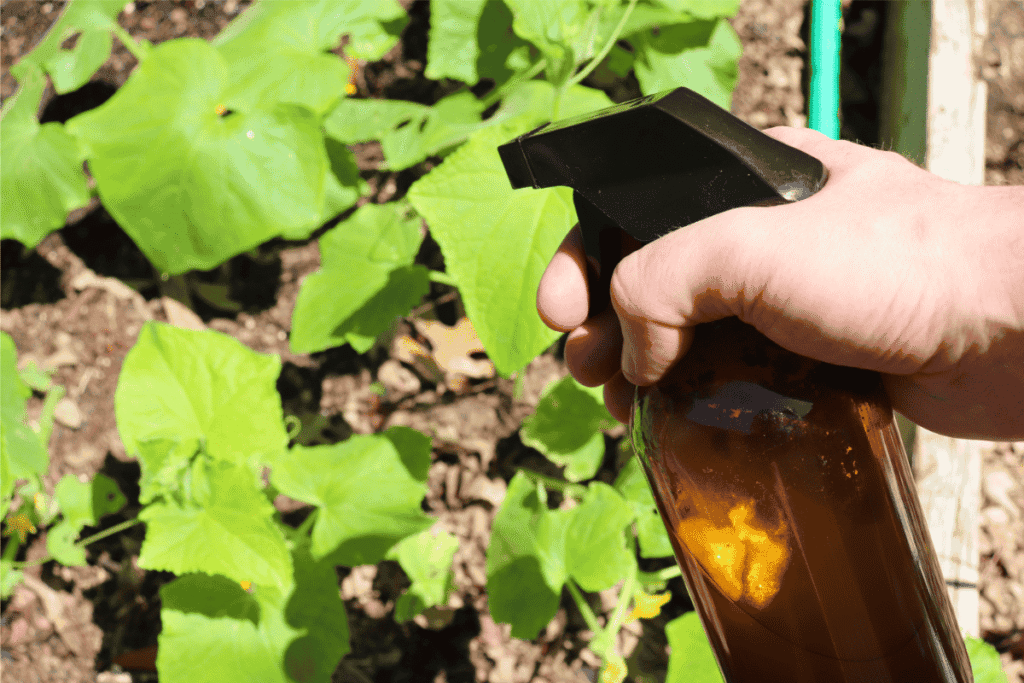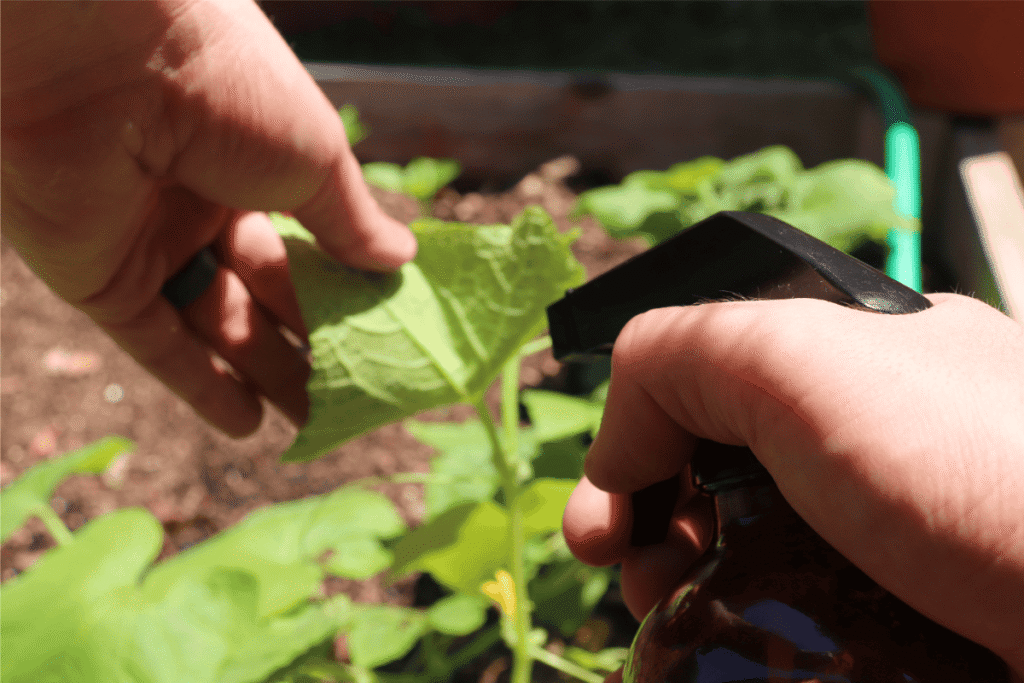This post may contain affiliate links. Read our disclosure policy here
There are few things more devastating to discover in your garden than an infestation of bugs munching on all of your hard work. Be it aphids, cucumber beetles, or caterpillars, if you are looking for organic pest control methods to rid yourself of these little terrors using natural means, look no further! Follow the steps below to bring harmful pest populations down to nearly nothing, or better yet, prevent them in the first place.

Setting Expectations With Organic Pest Control
One thing to note: Organic insecticides will never work as well as their chemical counterparts. It is not realistic for a product with high standards on health and safety to work the same as one with lower standards. There is a trade-off when you prioritize health and safety in your garden.
So check your expectations. The goal is to control the pests in your garden, and these methods will do that. BUT it will take consistency, hard work, and often using multiple methods at once. You will still see some pests here and there, but it will not become a problem for your garden if you are consistent.
1. Neem Oil Spray
After a nasty aphid infestation killed our black eyed peas and cucumbers last Summer, I began looking for ways to control garden pests without using harsh chemicals. I tried a few recommended organic pest control methods such as garlic or mint spray, but many of these made no noticeable difference.
The one that worked wonders was an organic neem oil solution made at home.

Neem oil is a natural, plant-based insecticide that is safe for your garden produce. Neem tree seeds have an active ingredient called azadirachtin that is naturally insecticidal, antifungal, and antibacterial. By mixing a spray with organic neem oil, water, and Castile Soap, you can make a simple, but effective organic insecticide.
The best thing about this solution is that you don’t have to wait until you have a problem to use it. It also works as a preventative measure to discourage harmful insects from ever targeting your garden.
A Note of Caution: Keep in mind that a neem oil solution is not partial to pests alone, but may also harm beneficial insects in your garden if they munch on your plants. To avoid harming bees, do not spray your neem oil solution on the flowers of your plants. Thankfully, most insects considered beneficial do not eat your plants and will not be harmed by the solution in any way. Just be sure to not accidently spray this directly on beneficial insects.
This post contains affiliate links, which means I make a small commission at no extra cost to you. See my full disclosure here.
How to Make Neem Oil Spray

Materials
- Organic Neem Oil: You can order this from Azure Standard or find it on Amazon.
- Castile Soap: We always use Dr. Bronner’s. You can order it from Amazon or find it at your local pharmacy and grocery store.
- 32 oz Warm Water: You can use water from the tap and warm it in a pot or the microwave.
Instructions
- Fill a 32oz spray bottle with warm water. You don’t want cold water because the oil will solidify and not mix properly. However, you don’t want it burning hot either.
- In a small bowl, add 1/2 tsp of Castile Soap and 1/2 Tbsp of Neem Oil. Mix thoroughly to emulsify the solution. This step is crucial to make sure your neem oil actually mixes into your warm water.
- Add the neem oil and soap mixture to your warm water and shake the dickens out of it to combine.
How to Use Neem Oil Against Garden Pests
Spray your neem oil solution on your plants once a week. Make sure to spray over AND under each leaf of your plant, effectively covering it all. Avoid the blossoms of your plants so that you don’t unintentionally harm the bees in your area.

Tips
- Do not spray your garden more than once a week because too much neem oil can burn your plants.
- Do not treat seedlings with neem oil. They will be too sensitive to it, and it can potentially damage them.
- While neem oil is safe for your plants, you don’t want to ingest it. Thankfully, it naturally wears off in less than a week, but you don’t want to spray produce you are just about to harvest. Be sure to wash your produce thoroughly in water before eating.
- If it is rains heavily, you may need to reapply the spray early. The rain can wash off the solution.
- Neem oil can also combat downey mildew if treated early enough!
2. Trap Plants
Another method for organic pest control is using trap plants. Using trap plants is a type of companion planting that is used specifically for controlling insects. Trap plants are things you plant that will divert pests away from your main crops and towards your trap plant instead. They are essentially your sacrificial plants.

This is a great humane method for those who do not want to harm any bugs. It is often less effective than other methods though and also takes up garden space. However, you will get some pretty blooms most of the time!
Different Kinds of Trap Plants
Nasturtiums
Nasturtiums (especially yellow varieties) are excellent trap plants with a multitude of benefits for your garden! Nasturtiums can help divert aphids, cucumber or squash beetles, and cabbage moths from your vegetables. They are also a great way to attract beneficial insects. Finally, nasturtiums are edible flowers known for a peppery taste. They are truly a super plant for your garden!
Dill
While dill is wonderful to have for its own harvest, it can also act as a trap crop to protect tomatoes from the tomato hornworm.
Tansy
This yellow flower can help protect potatoes from the Colorado Potato Beetle. It is also deer-resistant, is great as fresh-cut flowers, and deters flies and mosquitos too!
These are only the tip of the iceberg. If you want to know more about trap plants and how to use them, check out this guide, or do some of your own research for specific plants/pests.
How to Use Trap Plants as an Organic Pest Control Method
- Plant them early in the Spring before your other crops.
- Continue to stagger the planting of new trap plants to keep blooms throughout your growing season.
- Keep them in pots or grow directly in the ground to surround the crops you are trying to protect.
Keep in mind that trap plants are often not effective enough on their own without the use of another organic pest control method. Remember, you must be vigilant to control pests when gardening without the use of strong chemicals. It is not a “one and done” kind of solution. How nice would that be though!
3. Squish Them…

Some people may be against this, but this is the third step to natural pest control in our garden after neem oil and trap plants.
A neem oil spray alone takes care of about 80-90% of the harmful insects in our garden, but there are always a few left over trying their best to destroy all of our hard work. Sometimes, bugs are unyielding and you just need to start squishing them. So that’s what we do with the remaining insects. And it works great.
If we have an issue building, my husband will simply go out once or twice a day and squish the bugs he finds. And that is the last draw that takes care of any pest problems in our garden.
If you found this tutorial helpful, we would love for you to leave a comment below!
Check out our other gardening tutorials here.
Happy gardening!

Leave a Reply